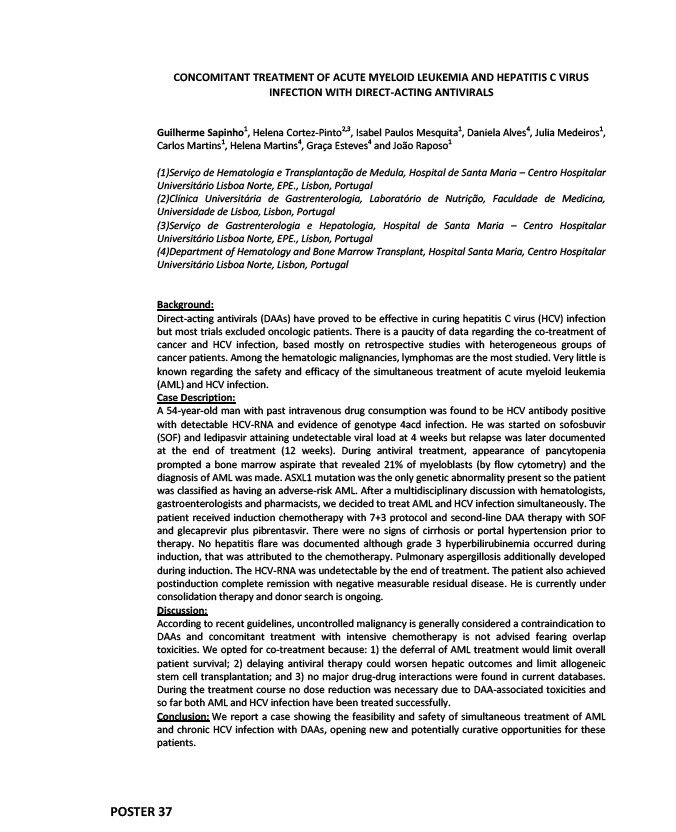
CONCOMITANT TREATMENT OF ACUTE MYELOID LEUKEMIA AND HEPATITIS C VIRUS
POSTER 37
INFECTION WITH DIRECT-ACTING ANTIVIRALS
Guilherme Sapinho1, Helena Cortez-Pinto2,3, Isabel Paulos Mesquita1, Daniela Alves4, Julia Medeiros1,
Carlos Martins1, Helena Martins4, Graça Esteves4 and João Raposo1
(1)Serviço de Hematologia e Transplantação de Medula, Hospital de Santa Maria – Centro Hospitalar
Universitário Lisboa Norte, EPE., Lisbon, Portugal
(2)Clínica Universitária de Gastrenterologia, Laboratório de Nutrição, Faculdade de Medicina,
Universidade de Lisboa, Lisbon, Portugal
(3)Serviço de Gastrenterologia e Hepatologia, Hospital de Santa Maria – Centro Hospitalar
Universitário Lisboa Norte, EPE., Lisbon, Portugal
(4)Department of Hematology and Bone Marrow Transplant, Hospital Santa Maria, Centro Hospitalar
Universitário Lisboa Norte, Lisbon, Portugal
Background:
Direct-acting antivirals (DAAs) have proved to be effective in curing hepatitis C virus (HCV) infection
but most trials excluded oncologic patients. There is a paucity of data regarding the co-treatment of
cancer and HCV infection, based mostly on retrospective studies with heterogeneous groups of
cancer patients. Among the hematologic malignancies, lymphomas are the most studied. Very little is
known regarding the safety and efficacy of the simultaneous treatment of acute myeloid leukemia
(AML) and HCV infection.
Case Description:
A 54-year-old man with past intravenous drug consumption was found to be HCV antibody positive
with detectable HCV-RNA and evidence of genotype 4acd infection. He was started on sofosbuvir
(SOF) and ledipasvir attaining undetectable viral load at 4 weeks but relapse was later documented
at the end of treatment (12 weeks). During antiviral treatment, appearance of pancytopenia
prompted a bone marrow aspirate that revealed 21% of myeloblasts (by flow cytometry) and the
diagnosis of AML was made. ASXL1 mutation was the only genetic abnormality present so the patient
was classified as having an adverse-risk AML. After a multidisciplinary discussion with hematologists,
gastroenterologists and pharmacists, we decided to treat AML and HCV infection simultaneously. The
patient received induction chemotherapy with 7+3 protocol and second-line DAA therapy with SOF
and glecaprevir plus pibrentasvir. There were no signs of cirrhosis or portal hypertension prior to
therapy. No hepatitis flare was documented although grade 3 hyperbilirubinemia occurred during
induction, that was attributed to the chemotherapy. Pulmonary aspergillosis additionally developed
during induction. The HCV-RNA was undetectable by the end of treatment. The patient also achieved
postinduction complete remission with negative measurable residual disease. He is currently under
consolidation therapy and donor search is ongoing.
Discussion:
According to recent guidelines, uncontrolled malignancy is generally considered a contraindication to
DAAs and concomitant treatment with intensive chemotherapy is not advised fearing overlap
toxicities. We opted for co-treatment because: 1) the deferral of AML treatment would limit overall
patient survival; 2) delaying antiviral therapy could worsen hepatic outcomes and limit allogeneic
stem cell transplantation; and 3) no major drug-drug interactions were found in current databases.
During the treatment course no dose reduction was necessary due to DAA-associated toxicities and
so far both AML and HCV infection have been treated successfully.
Conclusion: We report a case showing the feasibility and safety of simultaneous treatment of AML
and chronic HCV infection with DAAs, opening new and potentially curative opportunities for these
patients.